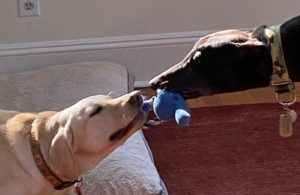Adopting a retired Greyhound is truly a rewarding experience. Your Greyhound will quickly become a member of your family and add joy to your home. Their playful and sensitive nature will endear them to everyone. Most importantly, adopting a Greyhound is a serious commitment. Your pet will depend on you for guidance and to meet all its needs; food, shelter, health care and lots of love.
The following information will help you decide if a retired racer is the right pet choice for you and your family.

Luna (10 month old lab) and Boone at play!
Greyhounds Are Quiet & Docile
Greyhounds are quiet animals who rarely bark. They love to sleep and are often fondly referred to as “40 Mile Per Hour couch potatoes.”
Personality: Greyhounds are quiet, well mannered, loving and sensitive. Because of their gentle nature, they do not make good watch dogs. Greys are easily trained with positive reinforcement. A firm NO! is all that is needed to correct unwanted behaviors.
Age: Greyhounds available for adoption are generally two to six years old. Their racing careers end when they are no longer competitive. Some are not fast enough, while others may have been injured.
Life Span: On average, Greyhounds live from 12 to 14 years.
Size: Like people, Greyhounds vary in size. Females weigh from 50 pounds for a petite girl to 60 pounds for the more average one. Males tend to be a bit larger, weighing between 65 and 75 pounds on average. Regardless of their size, greyhounds take up very little space and curl up into a ball when sleeping.
Color: Greyhounds come in a wide array of colors with 18 recognized variations. They are solid, patched, brindled, spotted and striped. The least common of all is the “blue” or gray-like color.
Greyhounds Are Greyt Companions
Greyhounds are happiest in the company of those they love. They eagerly await your arrival with wagging tails. They like to nuzzle, love people, love to love and to be loved.
Children: Are greyhounds good with children? The real question is, are children good with Greyhounds? Like any other breed, some will be o.k. and some will not. It is important to supervise children at ALL times. NEVER leave a young child alone with the dog. The child must learn that while the dog is sleeping it is off limits. They must not play in their crates, and they must NEVER tease, taunt, pull tails, ears, or ride the dog. THIS CAN POTENTIALLY CAUSE A DANGEROUS SITUATION. Any
dog will eventually snap or bite if put in this situation. Parents must teach the child to respect the
dog. For example, if the child is about to crawl onto the sleeping dog’s bed, the parent must react the same way she would if the child were about to touch a hot stove or run into the street, fast and firm. This reaction as opposed to, “Oh Johnny, now stay away from Rover o.k. sweetie” will let your child know that you mean business and this is not acceptable. Children and Greyhounds can live together peacefully if taught well.
Cats: Greyhounds and cats can and do get along! Many Greyhounds live happily with cats and other small animals. Be sure to let your adoption consultant know the make-up of your household so they can assist you with finding a cat friendly pet.
Exercise: Contrary to popular belief, Greyhounds do not require a tremendous amount of exercise. As racers, they are sprinters, not endurance runners. While they enjoy a good romp around a fenced yard or in an enclosed area, they do equally as well with a brisk ten minute walk daily. The rest of the time, they are content resting on a soft bed or sofa.
Walking: At the track the dogs are accus-tomed to 4 turn outs daily for bodily functions. Additionally, they are taught to walk well on lead. Greyhounds must always be leashed when walked outside of a safely fenced area. They may never be walked without a leash as they are sighthounds
and always ready for a good chase, even after a blowing paper bag or leaf
Greyhounds Are Smart
Many Greyhounds excel as therapy dogs. Others score well in agility and obedience. All find the perfect way to make themselves a member of the family.
Shedding: Greyhounds have short coats and are not big shedders. Some believe that lighter color dogs shed more than darker colors. A good weekly brushing with a comb or glove eliminates most shedding. Greyhounds are considered hypo-allergenic and are often suitable pets for those with
allergies.
House Breaking: Greyhounds spend most of their track life in a crate and have learned not to “dirty” their living space. Utilizing a crate at home while the grey adapts to his/her new environment quickly teaches them to see the home as a larger crate. House breaking is easily accomplished within a short period of time.
Feeding: The average grey requires 4 to 5 cups of high-quality dry food daily, spread over two meals. Thinner dogs may need more food until they reach their “pet weight.”
Special Needs: A Greyhounds short hair and lean body requires a coat when the temperature dips below 40 degrees. A non-slip, humane collar accommodates his/her narrow head and wider neck. Raised bowls make eating easier. A soft bed is always appreciated. Most of all, patience and love are the best tools to ease the transition from track to home.
